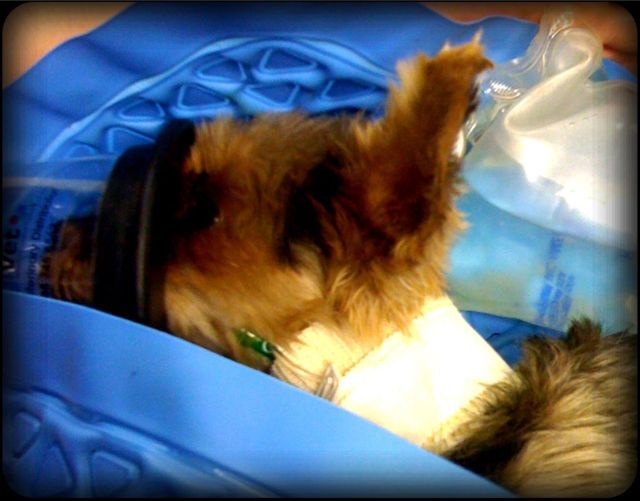Yorkshire Terrier Puppy Freezes
“There’s a lady on the phone. She says her dog is having trouble breathing. Can she bring the dog in now?” my Saturday receptionist asked, phone receiver dangling from her fingers.
“Of course, how long will it take her to get here?” I asked.
Wonderful receptionist replies, “She lives on 167th Street.”
I do rudimentary math in my head,” Oh, just a few minutes away.”
Now, “trouble breathing” in a patient we have not seen before means they probably do not enjoy regular preventative care. Anything could be wrong.
- Choking
- Heart failure
- Bronchitis
- Pneumonia
- Seizures
- Poisoning
We set up the oxygen mask, heating pad, and IV emergency box. A nurse waited on the front step of the clinic. Sometimes helping get a pet out of the car means life or death.
“Fendi” arrived within five minutes of a call. My nurse ran her limp 3 1/2 pound, 3 1/2 year-old skinny Yorkie body to the treatment table for heat and oxygen. I waited with my stethoscope poised.
I saw a tiny dog with pinpoint nonresponsive pupils. Her heart barely uttered a sound. There it is! About 30 beats in a minute. Terrible! A Yorkie should have 80, 100, even 110 beats a minute with no problems. I put my hand under the towel her mom had wrapped her in. Her body felt like wet, hard ice. Oh no!
She was nearly frozen stiff. We wrapped her in a circulating hot water pad, with hot water bottles snuggled against her back and her belly. When a rectal thermometer read Nothing, that meant her core body temperature was below 90 F. Her gums were grey and cold. Fendi had bubbly slimey saliva covering her teeth. Her little legs kicked weakly in random directions.
While the nurse searched for a vein with enough blood pressure to identify intravenous cathether placement, I asked Fendi’s mom, “What happened?”
“Fendi was running around outside for three hours with two shirts on. When I went out to get her, I found her like this. I can’t hear if she barks or asks to come in because I live in a big house and my room is far away from the door.”
That answered my main question, how could Fendi get like this and not bark or cry for help? She probably did and no one heard her.
In situations like this, I have to put aside my sadness and anger. Many accidents and unfortunate emergencies are preventable if people realize or watch their dog. Most people would never leave a tiny Yorkie unattended in the yard, especially on the coldest day of the year.
A tiny dog can:
- Get stolen
- Get lost
- Get captured by an owl or a hawk
- Or just plain get hurt and be too tiny to do anything about it
For these and many, many other reasons, go outside with your dog. Do not leave a dog unattended in the yard. Last year, Broward County, Florida (near me) actually passed a law making an unattended dog in the yard illegal between 10am and 4 pm because of extreme heat most of the year.
I’ve treated many dogs for heat stroke, but only once before for freezing. (That dog escaped and froze solid in mud in a swamp for three days. She made it!)
After one hour of heat, Fendi’s core body temperature registered on the thermometer at 92.1F! Enzymes and life functions slow and stop below 93. We were asking for a miracle.
After 70 minutes, her pupils responded to my penlight. Her body shivered. Her heartrate came up to 70.
By two hours, Fendi stood up and licked my face. She had no seizures, no paralysis. Fendi looked fine! What a happy, lucky miracle.
Her mom stood by and watched the whole time. She helped hold the oxygen mask when we asked her to. She was quiet and seemed unemotional. I guessed from my years of experience she was too upset for words. When Fendi pushed her little body to sit up, tears rolled down her mom’s face.
Fendi could still show symptoms of massive organ damage. After near death by freezing, kidneys could decide not to work. Brain damage could be worse than we think. Many other body systems could fail. BUT, Fendi walked, wagged her tail, and drank water from a syringe as soon as the warmed up to 98F.
What’s normal core body temperature in a dog? 101-102.5F.
We did something amazing today. We helped bring a miracle to life.






Wow. That is great that you were able to save her.